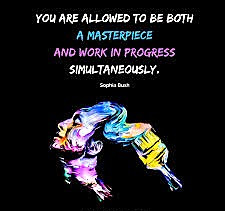《自律養生實踐家之旅297》 身教・口碑・精進之路

自從領悟「身體處理食物,就不處理廢物」這項身體的原始設定以來,我便清楚知道,光是傳遞這個觀念,就得不斷開課、不斷重複。截至目前為止,這堂課我已經講了兩千多次。
必須說,沒有任何兩堂課的內容是完全相同的。每次課前,我都會依當時的靈感重新梳理講解脈絡,為的是讓新學員順利打開通往身體意識的大門。讓大腦先理解,再交由直覺引發行動的動機。
與身體的合作,是一門需要熟練的藝術,而熟練來自於生活中的不斷練習。真正阻礙我們與身體磨合的,從來不是外界的噪音,而是腦中那些盤根錯節的念頭。我們其實心裡明白,只是常常無能為力。
為什麼會這樣?答案仍要回到「學習」二字。這堂課若沒聽懂,就仍是新人;與身體還未熟悉相處的人,仍然是新人。而自認為經驗老道、可不必再學的「老人」,因此停滯不前。
身為講者,我最想問的一句話是:「你是否真的懷抱著強烈的動機,想好好善待自己的身體?」因為,唯有「心與行」一致,才談得上轉化。
有些人考了駕照,卻從未上路;也有些人上了一次初階課,就從未真正學會善待自己的身體。身體的熟練,絕非靠產品灌輸,而是靠日復一日的實踐。
比如延長「不吃的時間」,看似簡單,卻需要高度的自律。而最直接的方式,就是讓自己置身於一個講求紀律的環境裡。
我深知,高比例的人無法持續學習的原因,並不是因為外在的誘惑太多,而是內在的心志不夠堅定、動機過於薄弱。
大腦的暗示總是潛伏在生活每個角落,那些「顧不了那麼多」的衝動、「消化負擔無所謂」的僥倖、「沒那麼嚴重」的自我安慰,都直通前功盡棄的嘆息聲。
如果只是為了減重,或是處理某個症狀,動機自然不強,也難以長久與身體合作。據我觀察,大約有五成學員,只是「來此一遊」,未能真正進入實修之境。
這其中,最常見的干擾,是來自「別人怎麼說」、「家人怎麼反對」。我一路走來,見證了無數人被親情嚇阻、被環境擄走。
這不是在陳述工作的艱難,而是在記錄一段人性之路:自律養生,是對生命本質的回應。我們不追求量的擴張,只鎖定質的深耕。
每個人身上其實都帶著「利他」的基因,想幫助人、想分享好事給親朋好友。然而最常失序的,正是「身教」尚未建立,就急於利他。
我從學員的行為模式中看到:不學習的人,往往帶來更多不學習的人;蜻蜓點水的介紹,只會引來同樣淺嚐輒止的回應;動機薄弱的人,很難帶領動機強烈者齊步同行。
因此,我鼓勵大家回頭檢視自己的利他初心,反觀自己正在示範什麼樣的身教。因為,你的子女與家人都在看,他們可能看好,也可能看衰,但關鍵是:你在他們面前,展現了什麼?
自組社群以來,「口碑」早已成為連結動機的橋樑,不只是團體的口碑,更是你個人的口碑。
我們不是在培養業務員,也不是在販售產品。我們靠文字與課程建立信任,靠持續學習的成員延續好口碑。
課堂中因應斷食常講到兩個觀念:「以終為始」與「延遲享樂」。多數人以為斷食是對享樂的壓抑,但實際上,斷食正是品味食物的根基。
「食物」到底是果腹的工具,還是享樂的載體?在這兩者之間,斷食像是正向的楚河漢界,引導我們回到與食物更深的關係。
以「懷胎十月」來比喻「以終為始」,再恰當不過。一旦確定懷孕,終點(孩子出生)就已在眼前,整段過程充滿意義,也充滿期待。
與身體合作,也該如此。目標只有一個:不生病。你得相信身體有這個能力,也要相信自己有足夠的身教去支持它。
回到斷食初體驗,許多人恐懼多過勇氣,明明決定要實行,卻被飢餓的幻影所困。那景象,像極了想想斷藥的人眼前不時浮現的幻魂。
這一切其實揭示了:我們的飲食頻率與分量出了問題,而藥物治療所灌輸的,則是對疾病的恐懼與焦慮。
深化斷食,是許多「自律養生」家人真正的修煉。他們的見地,甚至可以超越某些健康權威。
關鍵不在於他們擁有什麼神秘工具,而是他們徹底善用了與生俱來的身體天賦。
不熟悉身體之道,如何領悟真正的養生之道?
欲成為精進者,請走入自律養生的修行之路。
因為,唯有精進,才能真正走上與身體合作、與生命同在的康莊大道。
(你可以同時是一件完成的傑作,也是一個持續進行中的作品。)
Embodiment, Reputation, and the Path of Refinement
Ever since I realized the body’s primal setting—”when it is busy processing food, it cannot process waste”—I’ve known clearly that simply communicating this insight requires endless repetition. To date, I have given this particular class over two thousand times.
And yet, no two sessions have ever been the same. Before each one, I revisit the flow of the lecture, adjusting it based on present inspiration. The goal is always the same: to help new learners open the door to body awareness—to let the mind first understand, and then hand the motivation over to intuition.
Working with the body is a skillful art, one that must be practiced daily. What truly prevents us from syncing with our bodies is not external noise, but the tangled thoughts within our own minds. Deep down, we often know what to do—but feel powerless to act.
Why is that? The answer lies in one word: learning. If this fundamental lesson hasn’t landed, you’re still a beginner. If you’re not yet familiar with your body, you’re still a beginner. Those who consider themselves experienced and believe they’ve nothing more to learn—are, ironically, the ones most stuck.
As a guide, the question I most want to ask is:
“Do you genuinely carry a deep motivation to care for your body?”
Because only when heart and action align, can true transformation begin.
Some people earn their driver’s license but never drive. Others attend a single introductory session and mistakenly believe they’ve mastered how to care for their bodies. But bodily refinement is never the result of products or teachings—it comes from daily practice.
Take, for instance, simply extending the hours of not eating. It sounds simple, yet demands high-level discipline. And the most effective way to sustain it? Immerse yourself in a disciplined environment.
I know too well: most people fail to continue learning not because of too many temptations, but because of weak intention and insufficient will.
The mind whispers excuses from every corner of life: “I’ve got too much going on,” “It won’t hurt just this once,” “It’s not that serious.” These whispers lead straight to self-sabotage.
If your only motivation is weight loss or symptom relief, it won’t sustain a lasting collaboration with your body. In my observation, about half of all participants merely pass through, never entering the depths of real practice.
One of the most common sources of interference is:
“What others say” and “What my family thinks.”
Over the years, I’ve seen countless people pulled away—by family disapproval, by environmental pressure.
But this is not a complaint about how hard the work is—it’s a chronicle of human nature. Selfasteam is not a trend, but a profound response to life’s essence. We do not chase quantity—we commit to deepening quality.
Every human carries the gene for altruism—the desire to help others, to share goodness with those we love. And yet the greatest mistake is to leap into “saving others” before embodying the truth ourselves.
I’ve seen it repeatedly: those who don’t learn often invite others who don’t learn. Superficial introductions lead to equally superficial engagement. Those with weak motivation rarely inspire the deeply committed to join them.
That’s why I encourage each person to revisit their altruistic intent, and ask:
What kind of example are you setting through your embodiment?
Because your children and loved ones are watching.
They may admire you—or they may doubt you—but what truly matters is:
What are you showing them?
Since the founding of our community, reputation has become the bridge of motivation—not just the group’s reputation, but your personal reputation.
We are not training salespeople. We are not selling products.
We build trust through words and classes; we sustain credibility through learners who keep learning.
Two recurring concepts often appear in our fasting courses:
“Begin with the end in mind” and “Delay gratification.”
Most people think fasting is about denying pleasure—but in truth, fasting is the foundation of deeply savoring food.
Is food merely a tool to silence hunger, or a vehicle of pleasure? Between these two, fasting becomes a positive dividing line—guiding us back into a more meaningful relationship with nourishment.
To use an analogy, “begin with the end in mind” is like the ten-month pregnancy journey. The moment conception is confirmed, the outcome—birth—is already in sight. The entire process becomes meaningful, filled with anticipation.
Cooperating with the body should be no different.
The goal is singular: do not get sick.
Believe in your body’s capacity—and believe in your own ability to support it through your embodied example.
Back in the early days of fasting, many people feel more fear than courage. Though they decide to start, they’re haunted by visions of hunger—just as those wishing to quit medications are haunted by withdrawal fears.
But these reveal a deeper truth:
Our eating frequency and volume are out of balance, and medicine has ingrained in us a fear of illness.
Going deeper into fasting is a genuine practice for many in the Selfasteam circle. Their insights often surpass those of traditional health authorities.
Not because they possess secret tools,
But because they have fully embraced their innate bodily intelligence.
If you’re not familiar with the way of the body, how can you understand the true path of self-healing?
If you seek to refine yourself,
walk the path of Selfasteam.
Because only through refinement can you truly walk the bright, open road—
in partnership with your body,
in harmony with your life.


